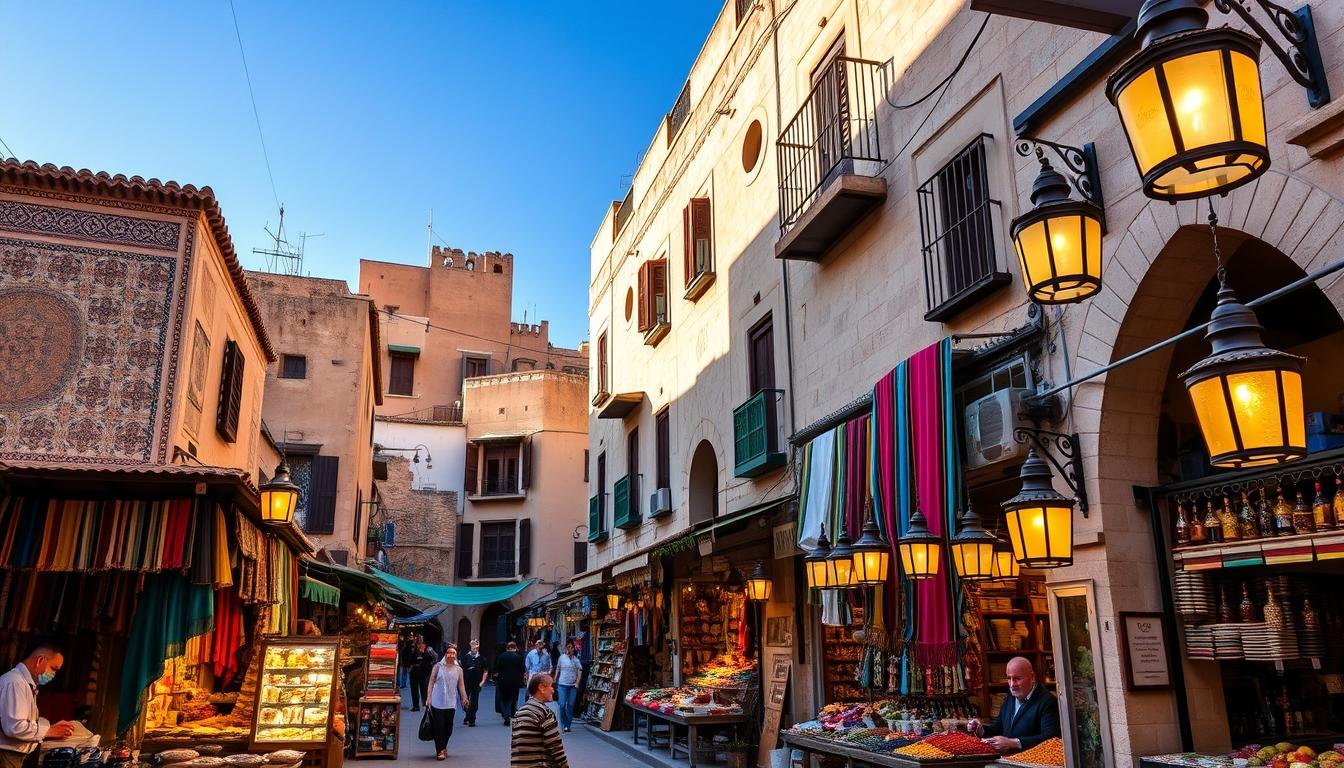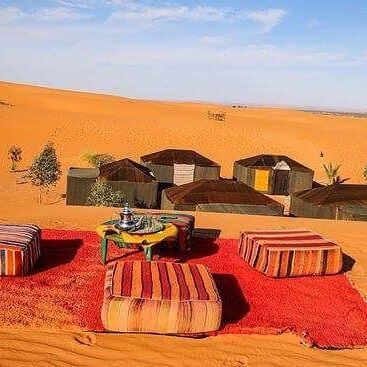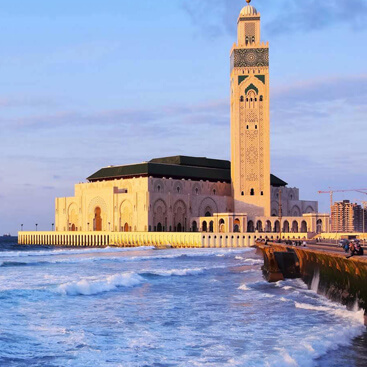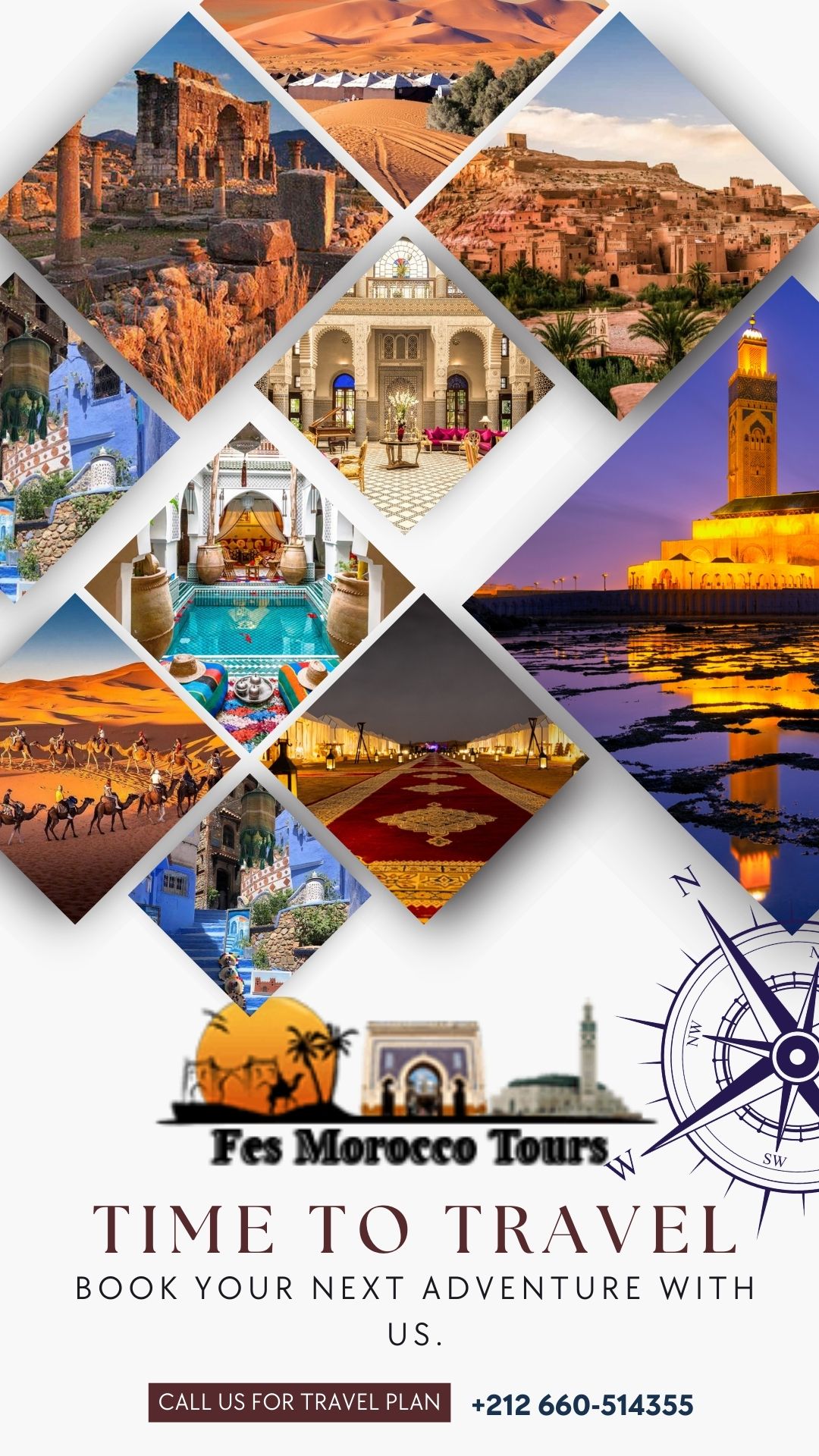
Exploring the Medina of Fès: A UNESCO World Heritage Site
Walking through Fès's narrow alleys, I was struck by the city's colors and history. The Medina of Fès, or Fès el-Bali, is more than a UNESCO World Heritage Site. It's a living piece of Moroccan culture and Islamic architecture. Every corner of this ancient city tells a story, from the lively souks to the tall minarets.
Medina of Fes
A vibrant, bustling scene of the Medina of Fès, showcasing intricate mosaics and architectural details, narrow winding streets filled with artisans at work, colorful textiles hanging from shopfronts, fragrant spices in open-air markets, traditional Moroccan lanterns casting warm light, and historic stone buildings under a clear blue sky.
Key Takeaways
- Fès is one of the oldest continuously inhabited cities in the world, with a history spanning over a millennium.
- The Medina of Fès is a UNESCO World Heritage Site, recognized for its exceptional cultural significance and preservation.
- Fès quickly became a center of Islamic learning and culture, reaching its peak of influence during the 12th to 14th centuries.
- The Medina of Fès is one of the largest car-free urban areas globally, offering a unique and immersive experience.
- Fès is less popular than Marrakech but offers its own distinct sights, sounds, and experiences that are not to be missed.
Introduction to the Historical City of Fès
Fès, Morocco's second-largest city, is a place of wonder. It mixes its Islamic past with a lively culture. Founded in 789 CE, it quickly became a key spot for Islamic learning and culture.
Origins and Islamic Heritage
The city shows its Andalusian and Marinid dynasty roots in its medieval layout. This includes the famous Al-Qarawiyyin Mosque and University, the oldest university still in use. Fès is known worldwide for its Islamic scholarship and cultural heritage.
UNESCO World Heritage Status
The Medina of Fès was named a UNESCO World Heritage site in 1981. This honor highlights the city's value as a living piece of history and architecture.
Cultural Significance in Morocco
Fès is seen as Morocco's spiritual and cultural heart. It's filled with traditions, crafts, and food passed down through generations. Its unique heritage makes it a key spot for exploring Moroccan history and identity.
Historical Monuments in Fes
"Vibrant scene showcasing the intricate architecture of historical monuments in the Medina of Fès, featuring ornate tile work and grand facades, traditional Moroccan buildings surrounded by bustling market stalls, rich colors and textures, against a clear blue sky."
"Fès is a city of endless surprises, where the past and present coexist in a captivating dance of centuries-old traditions and modern influences."
Getting to and Around the Medina of Fes
Exploring the Fez Medina is a magical experience. This historic Medina of Fez is a UNESCO World Heritage Site. It's famous for its narrow streets and no cars, making it perfect for walking.
The Fès-Saïs International Airport (FEZ) is just 15 km from the city center. Airlines like Air Arabia and Royal Air Maroc fly here. From the airport, local bus #16 goes to the main train station for 4 dirhams.
Trains connect Fez to places like Marrakech and Casablanca. The Fez gare routière (bus station) offers bus services to North Morocco.
Walking is the best way to see the Medina. It's small and easy to explore. For short trips, use petits taxis for 15-20 dirhams.
The Medina of Fez is one of the world's biggest car-free areas. It lets visitors enjoy its old-world charm and culture. The historic Medina of Fez is unforgettable, showing the heart of medieval Medina life.
Best Time to Visit and Trip Planning Essentials
Exploring the Medina of Fes, Morocco, is best at the right time. The city's weather changes with the seasons. So, it's key to think about these changes when planning your Fes Morocco tours.
Seasonal Considerations
Summer in Fes can be very hot, with temperatures up to 36°C (97°F). Winter is cooler, with highs around 17-18°C (63-64°F) and more rain. The best times to visit are March to April and September to November. The weather is nice, and there are fewer people around.
Recommended Duration
Visiting Fes for at least two days is best. Two nights are even better for a relaxed trip. This lets you enjoy the city's history and culture slowly. You might also visit Marrakech and Chefchaouen as part of your Moroccan trip.
Essential Travel Tips
- Wear comfortable shoes for walking on the uneven surfaces of the Medina.
- Respect local customs and etiquette, particularly when visiting religious sites.
- Be prepared for the unique sensory experience of the Medina, with its vibrant sights, sounds, and smells.
- Familiarize yourself with the layout of the Medina and consider hiring a local guide to navigate the intricate alleyways.
- Carry cash, as many establishments in the Medina do not accept credit cards.
Traditional Riads: Authentic Moroccan Accommodation
Staying in a traditional riad in Fes Medina is a unique Moroccan experience. These historic buildings are famous for their detailed Moroccan architecture. They show the rich culture of the area. Fes is known for its captivating riads, each a unique time machine.
Notable riads in Fes include Riad Fes and Riad Fes Maya. Le Grand Alcazar has traditional Fes designs. Palais Amani offers luxury with cooking classes. Dar Seffarine is a 600-year-old restored building with beautiful zellige tilework.
"Staying in a riad provides a unique glimpse into Moroccan history and culture in a car-free environment."
Choosing a riad in Fes, whether luxurious or modest, will be a highlight of your trip. It will immerse you in the timeless charm of the city.
Architectural Marvels and Historical Monuments
Fez, Morocco's ancient capital, is filled with Islamic architecture and historical sites. The old town, Fez el-Bali, is a UNESCO site. It shows a mix of Oriental, Andalusian, and African styles.
Al-Qarawiyyin Mosque and University
The Al-Qarawiyyin Mosque and University is at the heart of Fez. Founded in 859 AD, it's the oldest university still in use. It has greatly influenced the area's culture and learning for over a thousand years.
Bab Boujloud (Blue Gate)
The Bab Boujloud, or "Blue Gate," is the main entrance to Fez's old Medina. Built in the 20th century, it's known for its bright blue and green tiles. It's a key spot for those exploring the historic center.
Marinid Madrasas
In the 14th century, the Marinid dynasty built beautiful Islamic schools in Fez. Places like the Al Attarine Madrasa are famous for their tile work, carvings, and wooden ceilings. They show the skill of the time.
"The Medina of Fez is a testament to the enduring legacy of Moroccan Islamic architecture, preserving the rich cultural heritage of the region for generations to come."
The Famous Chouara Tannery
The Chouara Tannery is in the heart of Fès's Medina. It's a place where tradition meets skill. For over a thousand years, it has been making leather the old way.
Chouara is the biggest tannery in Fès. It shows how raw hides become the soft, colorful leather we love. The process uses cow urine and pigeon poop, just like it has for centuries.
The smell of the tannery is unforgettable. To help with the strong smells, shops give out mint. On tours, you see tanners working in dye pits. They use natural colors like poppy for red and indigo for blue.
"The Chouara Tannery is a captivating glimpse into Morocco's enduring Fez tanneries and the dedication of its skilled artisans."
After the leather is made, it dries on rooftops. This lets visitors see the old ways up close. A trip to the Chouara Tannery is essential for understanding Fès's rich culture.
Exploring the Vibrant Souks and Markets
Fes is famous for its lively souks. Here, you can dive into the world of Moroccan crafts and artisanal goods. The Fes el-Bali markets, in the historic medina, are a bustling spot. They give you a peek into the city's rich culture.
Traditional Crafts and Artisans
Walking through the alleys, you'll see skilled artisans with their handcrafted items. You'll find everything from beautiful Moroccan ceramics and metalwork to stunning textiles and leather goods. The Rainbow Street is especially colorful, but it can get crowded.
Shopping Tips and Bargaining Culture
- Bargaining is key in Fes's traditional souks. Be ready to negotiate with vendors, as it's part of the culture.
- Know the average prices for different items to get a good deal. If an offer seems too high, feel free to walk away.
- Watch out for scams like bait-and-switch or pushy sales. Trust your gut and don't buy anything that makes you uncomfortable.
Local Specialties
The Fes el-Bali markets are known for their local treasures. You'll find amazing leather goods from the famous tanneries, detailed ceramics, and gorgeous handwoven textiles. These items make perfect souvenirs and gifts, bringing a bit of Morocco home with you.
"Fez is a city that captivates the senses. The sights, sounds, and smells of the bustling souks are truly unforgettable."
Culinary Journey Through the Medina
Fes, Morocco's cultural heart, offers a rich food experience. As you explore the Medina, a UNESCO World Heritage site, you'll find many traditional dishes. These will excite your taste buds.
In the Souk el-Attarine, the spice and perfume market, the air is filled with scents. You'll find saffron, cinnamon, and cumin. Local eateries in the Medina serve authentic Moroccan dishes, like tagine and sweet pastries.
Join a Fes food tour for a deep dive into Moroccan cuisine. You'll try local dishes and learn about their cultural importance. It's a chance to explore the Medina's flavors and traditions.
FAQ
What is the significance of the Medina of Fes?
The Medina of Fes, also known as Fes el-Bali, is a UNESCO World Heritage Site. It's one of the largest car-free urban areas in the world. It's famous for its medieval architecture, traditional souks, and ancient Islamic buildings.
When was Fes founded and what is its cultural significance?
Fes was founded in 789 CE. It quickly became a key center for Islamic learning and culture. It gained UNESCO World Heritage status in 1981, highlighting Morocco's rich Islamic and Andalusian heritage.
How can I get to the Medina of Fes and navigate within it?
The Medina of Fes is best explored on foot. Its narrow alleys and corridors make it perfect for walking. Taxis can take you to the airport or train station. Staying in the Medina gives you easy access to major sights.
What is the ideal duration for visiting Fes?
Spend at least two days in Fes for a full experience. Two nights are even better for a relaxed visit. You can also visit Fes as part of a larger Moroccan trip, between Marrakech and Chefchaouen.
What are the best riads to stay in within the Medina of Fes?
Riad Fes, Riad Fes Maya, Le Grand Alcazar, Palais Amani, and Dar Seffarine are top choices. These riads offer a true Moroccan experience with beautiful designs, luxury, and great views.
What are the must-see historical monuments in Fes?
The Al-Qarawiyyin Mosque and University is a must-see. It's the world's oldest university. Bab Boujloud, or the Blue Gate, is the main entrance to the old Medina. The Marinid Madrasas, like Al Attarine Madrasa, show stunning 14th-century Islamic architecture.
What is the Chouara Tannery, and what can I expect to see there?
The Chouara Tannery is over a thousand years old. It's the most famous tannery in Fes. Visitors can see the tanning process from leather shops. A local guide is recommended to explore the area and see the dye pits up close.
What can I expect to find in the souks of Fes?
Fes's souks are known for traditional crafts like ceramics, textiles, and metalwork. Rainbow Street is a vibrant shopping area, but it can be busy. Bargaining is key, and knowing common scams is important.
What are the culinary highlights of Fes?
Fes offers a wide range of culinary experiences. From street food to fancy restaurants, there's something for everyone. Try the Ruined Garden Restaurant for a unique dining experience. Local eateries in the Medina serve authentic Moroccan dishes. Don't miss the spice and perfume market at Souk el-Attarine. Cooking classes are also available at some riads.
Related Tours

Marrakech to zagora 2 days
It is a long established fact that a reader will be distracted by the readable content
Read More2 Days
Marrakech to zagora

Marrakech to fes desert tours 2 days
It is a long established fact that a reader will be distracted by the readable content
Read More2 days
Marrakech to fes desert tours

Casablanca desert tours 8 days
It is a long established fact that a reader will be distracted by the readable content
Read More